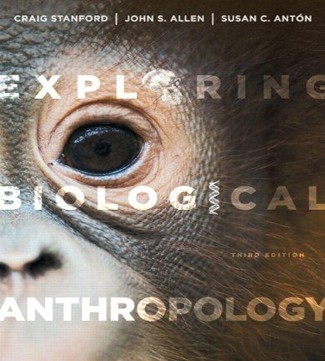Instant download Exploring Biological Anthropology The Essentials 3rd Edition Stanford Allen pdf docx epub after payment.

Chapter 3 Genetics: Cells and Molecules
In this revision of the testbank, all of the questions have been updated to reflect changes in Exploring Biological Anthropology, 3e. There is also a new system for identifying the difficulty of the questions. In this revision, the questions are now tagged according to the four levels of learning that help organize the text. Think of these four levels as moving from lower-level to higher-level cognitive reasoning. The four levels are:
REMEMBER: a question involving recall of key terms or factual material
UNDERSTAND: a question testing comprehension of more complex ideas
APPLY: a question applying anthropological knowledge to some new situation
ANALYZE: a question requiring identifying elements of an argument and their interrelationship
Types of Questions
Easy to Difficult Level of Difficulty
| Multiple Choice | Essay | Total Questions | |
| Remember | 42 | 0 | 42 |
| Understand | 47 | 2 | 49 |
| Apply | 13 | 6 | 19 |
| Analyze | 0 | 2 | 2 |
| 102 | 10 | 112 |
1. A basic understanding of heredity __________.
a. is a relatively new phenomena
b. did not happen until we fully understood DNA
c. can be found in almost all human cultures
d. requires a thorough understanding of genetics and reproduction
(REMEMBER; Answer c; page 31)
2. The term “gene” was coined by __________.
a. Jean Lamarck
b. Wilhelm Johannsen
c. Charles Lyell
d. Gregor Mendel
(REMEMBER; Answer b; page 32)
3. The term “gene” was coined after DNA was observed.
a. True
b. False
(UNDERSTAND; Answer b; page 32)
4. Cellular and molecular genetics involves the study of __________.
a. pedigrees of related individuals
b. how species divide into populations
c. the evolutionary relationships among species
d. cells and DNA
(REMEMBER; Answer d; page 32)
5. Scientists working on genetic therapies for disease are working in which genetic field?
a. phylogenetics
b. population genetics
c. Mendelian genetics
d. molecular genetics
(UNDERSTAND; Answer d; page 32)
6. Classical or Mendelian genetics involves the study of __________.
a. pedigrees of related individuals
b. how individuals vary within populations
c. the evolutionary relationships among groups of species
d. cells and DNA
(REMEMBER; Answer a; page 32)
7. Classical geneticists focus more on __________ than __________.
a. molecules, pedigrees
b. cells, populations
c. traits, molecules
d. populations, traits
(APPLY; Answer c; page 32)
8. A geneticist tracking how various traits are passed from one generation to the next is engaged in __________.
a. phylogenetics
b. population genetics
c. Mendelian genetics
d. molecular genetics
(UNDERSTAND; Answer c; page 33)
9. Population genetics involves the study of __________.
a. pedigrees of related individuals
b. how individuals vary within populations
c. the evolutionary relationships among species
d. cells and DNA
(REMEMBER; Answer b; page 32)
10. A geneticist studying the variation between different groups of organisms of the same species is engaged in __________.
a. phylogenetics
b. population genetics
c. Mendelian genetics
d. behavioral genetics
(UNDERSTAND; Answer b; page 32)
11. Population geneticists only study traits at the molecular level.
a. True
b. False
(APPLY; Answer b; page 32)
12. The genetic field of phylogenetics is concerned with __________.
a. determining evolutionary relationships between species
b. studying varying groups within the same species
c. constructing pedigrees
d. none of these
(REMEMBER; Answer a; page 32)
13. A geneticist constructing tree-like diagrams that visually indicate relationships between species is engaged in __________.
a. behavioral genetics
b. molecular genetics
c. phylogenetics
d. population genetics
(REMEMBER; Answer c; page 32)
14. Phylogenetic analysis often employs the methods of molecular genetics.
a. True
b. False
(UNDERSTAND; Answer a; page 32)
15. Behavioral genetics is the study of how __________.
a. behavior influences genetics
b. pedigrees are influenced by genetic relationships
c. phylogenies effect behavior
d. genetics influence behavior
(UNDERSTAND; Answer d; page 33)
16. Which of the following is the most controversial field?
a. behavioral genetics
b. molecular genetics
c. phylogenetics
d. population genetics
(APPLY; Answer a; page 33)
17. Human biological variability arises from __________.
a. mostly genetic influences
b. mostly cultural influences
c. both of these
d. neither of these
(UNDERSTAND; Answer c; page 33)
18. Which of the following is NOT a metaphor for genes used by modern scientists?
a. blueprint
b. homunculus
c. recipe
d. information storage
(APPLY; Answer b; page 35)
19. Which of the following is the perfect metaphor for genes and how they behave?
a. homunculus
b. recipe
c. information storage
d. none of these
(APPLY; Answer d; page 33)
20. The basic building block of life is the __________.
a. cell
b. gene
c. homunculus
d. organism
(REMEMBER; Answer a; page 33)
21. Which of the following is an example of a multicellular organism?
a. bacteria
b. protozoa
c. worms
d. archaea
(APPLY; Answer c; page 33)
22. The marine sea slug is commonly studied because it possesses cells.
a. larger
b. colored
c. more
d. fewer
(REMEMBER; Answer d; page 33)





